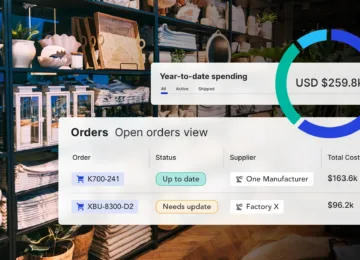Inventory tracking has quickly become one of the most crucial aspects of doing business. If you carry too little, you risk being unable to fulfill the order. However, if you have overstock, depreciation, shrinkage, and unnecessary handling, storage costs become a threat. Either way, your balance sheet and revenue will feel the brunt.
But effective inventory tracking isn’t just monitoring how much inventory you hold. It requires knowing the status of materials, components, assemblies, and finished goods at every stage of the process.
In this blog, we’ll delve into the benefits of inventory tracking for your supply chain, take a look at the common challenges organizations face when monitoring inventory, and offer 5 tips for optimizing inventory tracking to boost success.
First, let’s take a look at what exactly inventory tracking is.
What Is Inventory Tracking?
For manufacturers and businesses distributing physical goods, satisfying customer demand means supplying a product. This is achieved by moving materials through the supply chain, from supplier to manufacturer to warehouse. Knowing how much product is on the shelf, where it is, and when more will become available is central to on-time order fulfillment.
Every business storing and moving physical materials — including small businesses and those engaged in ecommerce — needs effective inventory control methods.
Inventory tracking looks a little different for every business. Some still use paper card systems. Others have stepped up to using Excel spreadsheets. Some have implemented sophisticated inventory management software to optimize their processes and be as efficient as possible.
How Does Inventory Tracking Impact Supply Chain Management?
Tracking inventory is central to ordering materials at the right time, planning production, and satisfying customer demand. It’s also a factor in managing costs and cash flow. An effective inventory tracking system updates whenever new information is received and enables timely decision-making.
This impacts the supply chain in several ways, including:
- Inventory: Visibility into your inventory levels and knowledge of delivery lead times enables lower stock levels. This saves money and reduces storage needs.
- Inventory Turnover: Inventory turnover measures how fast stock or product is sold. It may be calculated as an aggregate number or for individual SKUs. When applied to individual items, inventory turnover shows which items are moving quickly and which are not. This supports decision-making regarding inventory levels and even whether to drop or expand particular product lines.
- Customer Returns: For every $1 billion in sales, the average retailer incurs $165 million in merchandise returns, according to the National Retail Federation. Once returns come in, the business reviews them and decides what to do with them. Some will go back into inventory, others may be reworked, repaired, or reconditioned, and a proportion will be scrapped. Every one of these items needs to be tracked since the business needs to know what was returned and what happened to the item after it was returned. This can inform decisions about quality improvement, product design and development, and stock levels.
- Carrying Costs: Holding material in storage or product on shelves incurs expenses. These inventory carrying costs include lighting and heating warehouses, forklifts and their drivers, and other associated expenses. Inventory tracking is key to controlling these costs. When businesses know exactly how much inventory is in storage — and where it is — they can make better decisions about holding or disposing of the material.
- Damaged Goods: Unfortunately, not every pound or foot of input material becomes a saleable product in manufacturing: a proportion may be damaged during production. Similarly, some materials and finished products get damaged afterward during transit.
The inventory tracking system must capture these numbers to support reordering and issuing work to production. Not taking damaged goods into account guarantees shortages and missed deliveries.
Common Inventory Tracking Challenges
Tracking inventory can be a highly complex process, however. Most businesses have multiple raw materials, hold components at intermediate states of completeness, and sell a range of products sliced and diced into many combinations, sizes, and pack formats.
This complexity dictates the use of a formal inventory management system that retains and updates every record in a timely manner. What’s more, as the number of different items that need tracking grows, so do the challenges.
For example, a business may sell a variety of items that translate to a wider range of sizes, colors, materials, components, and subassemblies. This increases the size of the inventory tracking task, requiring a system that can scale. One that provided adequate functionality when variety was low may not be able to grow to meet the new challenge.
Businesses are also under pressure to reduce delivery lead times. As such, many have started storing goods closer to their customers, which means holding the same SKU in multiple locations. Your inventory tracking system needs to track the stock held at each location and perhaps apply different reorder points at each one. It should also provide a total of each SKU held in stock to facilitate forecasting and support transfers between storage locations. Besides SKU tracking, you may need to do Lot # tracking. These are based on when the manufacturing runs take place.
At the same time, though, many businesses are dealing with an outdated system or one that hasn’t scaled with the business. This may require them to do a lot of manual inventory data entry, which increases the risk of transcription errors and takes a lot of time. This is particularly true when SKUs and storage locations are increasing.
Tips for Effective Inventory Tracking
There’s no single best way to track and manage inventory. Rather, businesses should choose the tools and methods that best fit their practices and procedures. However, there are some common themes or principles — let’s explore five of these.
1) Utilize an Inventory Tracking System (ITS)
Businesses satisfy customer demand from inventory. The challenge is building safety stock for each SKU while still having a sufficient amount on hand to fulfill orders promptly.
This optimization is achieved by using an ITS. Functionality should include the ability to:
- Update quantities in the warehouse the moment deliveries are received.
- Deduct losses due to damage quickly to keep the stock levels accurate.
- Initiate reordering based on inventory dropping below reorder levels.
2) Reduce Costs With Inventory Forecasting
Inventory forecasting is about determining how much will be needed. This reduces costs associated with carrying inventory by lowering total inventory levels. It entails looking at historical records, seasonality, and predicted future demand and using all that information to determine what, when, and how much to order. A business can minimize the number of items and SKUs placed in the warehouse by looking ahead — which, in turn, reduces warehousing costs.
Businesses should forecast frequently, considering new information as it becomes available and adjusting stock levels and procurement plans accordingly.
3) Automate Time-consuming Tasks
Maintaining accurate inventory data requires almost constant data entry. Delays are inevitable with heavily manual processes, and there are greater risks for human error — both of which can be expensive in terms of money, reputation, and customer satisfaction.
Many ITS tasks are readily automated. One method is to implement barcode scanning throughout the operation to update records quickly and accurately.
4) Perform Cycle Counts
Cycle counting measures data accuracy in the warehouse or factory. A good ITS supports the planning and management of cycle counting by producing lists of SKUs and locations on a scheduled basis. Workers then visit those locations to verify that the records are correct — or identify discrepancies. If they do find errors, they update the ITS accordingly.
5) Conduct Frequent Audits
Mistakes can happen. Products can be put in the wrong location, quantities may be wrong, or scans omitted completely. In some environments, theft can even be an issue.
Auditing inventory verifies that businesses follow the correct procedures and that technology is working to identify any problems. The auditing process is worthwhile throughout the supply chain: For example, if a POS system isn’t updating stock records correctly, an audit will detect it, and staff can take appropriate action.
Streamline Your Inventory Tracking With Anvyl
Inventory management is undertaken in every business supplying physical goods. Minimizing inventory levels drives down costs, but going too far risks being unable to fulfill sales orders on time.
Inventory tracking systems provide visibility into inventory throughout the supply chain, from suppliers to manufacturing, warehousing, and distribution. There are many types of inventory tracking systems, but they all have two things in common: accuracy and visibility.
Anvyl integrates and partners with best-in-class inventory management systems to provide more visibility into your supply chain. To learn how your IMS and Anvyl can work together, chat with our team to learn more.


